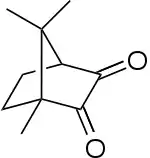 | |
| Names | |
|---|---|
| IUPAC name
2,6-Bornanedione | |
| Other names
Camphorquinone 6-Oxocamphor CQ CPQ | |
| Identifiers | |
3D model (JSmol) |
|
| ECHA InfoCard | 100.030.728 |
PubChem CID |
|
| UNII | |
CompTox Dashboard (EPA) |
|
| |
| Properties | |
| C10H14O2 | |
| Molar mass | 166.220 g·mol−1 |
| Melting point | 197-203 |
Except where otherwise noted, data are given for materials in their standard state (at 25 °C [77 °F], 100 kPa).
Infobox references | |
Camphorquinone, also known as 2,3-bornanedione, is an organic compound derived from camphor. A yellow solid, it is used as a photoinitiator in curing dental composites.[1] Camphorquinone is produced by the oxidation of camphor with selenium dioxide.[2]
Photocuring details
Polymerization is induced very slowly by camphorquinone, so amines such as N,N-dimethyl-p-toluidine, 2-ethyl-dimethylbenzoate, N-phenylglycine are generally added to increase the rate of curing.[1]
It absorbs very weakly at 468 nm (extinction coefficient of 40 M−1·cm−1) giving it a pale yellow color.[1] Photoexcitation results in nearly quantitative formation of its triplet state through intersystem crossing and very faint fluorescence.[3]
Reactions
It can be hydrolyzed by the enzyme 6-oxocamphor hydrolase.
Camphorquinone has been examined as a reagent in organic synthesis.[4]
References
- 1 2 3 Jakubiak, J.; Allonas, X.; Fouassier, J.P.; Sionkowska, A.; Andrzejewska, E.; Linden, L.Å.; Rabek, J.F. (August 2003). "Camphorquinone–amines photoinitating systems for the initiation of free radical polymerization". Polymer. 44 (18): 5219–5226. doi:10.1016/S0032-3861(03)00568-8.
- ↑ White, James D.; Wardrop, Duncan J.; Sundermann, Kurt F. (2002). "Camphorquinone and Camphorquinone Monoxime". Organic Syntheses. 79: 125. doi:10.15227/orgsyn.079.0125.
- ↑ Allonas, Xavier; Fouassier, Jean-Pierre; Angiolini, Luigi; Caretti, Daniele (19 September 2001). "Excited-State Properties of Camphorquinone Based Monomeric and Polymeric Photoinitiators". Helvetica Chimica Acta. 84 (9): 2577. doi:10.1002/1522-2675(20010919)84:9<2577::AID-HLCA2577>3.0.CO;2-Q.
- ↑ Luo, Yong-Chun; Zhang, Huan-Huan; Wang, Yao; Xu, Peng-Fei (2010). "Synthesis of α-Amino Acids Based on Chiral Tricycloiminolactone Derived from Natural (+)-Camphor". Accounts of Chemical Research. 43 (10): 1317–1330. doi:10.1021/ar100050p. PMID 20672798.